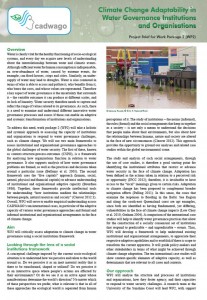Institutions and organisations
 The work package ‘Climate change adaptability in water governance institutions and organisations’ will critically assess adaptation to climate change in water governance using a social institutions framework.
The work package ‘Climate change adaptability in water governance institutions and organisations’ will critically assess adaptation to climate change in water governance using a social institutions framework.
Water is clearly vital for the healthy functioning of socio-ecological systems, and every day we acquire new levels of understanding about the interrelationship between water and climatic events. Although sufficient water for human consumption is indispensable, an over-abundance of water, caused by extreme events, for example, can flood houses, crops and cities. Similarly, an under supply of water may lead to droughts. Water is also contested in terms of who is able to access and pollute it, who benefits from it, who bears the costs, and whose values are represented. Therefore a key aspect of water governance is the uncertainty that surrounds it – the variable outcomes it can produce at different scales, and its lack of linearity. Water security therefore needs to capture and reflect the range of values related to its governance. As such, there is a need to examine and understand different innovative water governance processes and assess if these can enable an adaptive and systemic transformation of institutions and organisations. To address this need, work package 2, Climate Change Adaptability in Water Governance Institutions and Organisations will take a holistic and systemic approach to assessing the capacity of institutions and organisations to respond to water governance challenges, such as climate change. We will use two main frameworks to assess institutional and organisational governance approaches to the global challenges of water security.
This work package is led by Sustainability Research Centre at the University of the Sunshine Coast, Australia. Main contacts are Prof. Tim Smith (WP2 theme leader), Dr. Dana Thomson, Dr. Maria de Lourdes Melo Zurita (mmelozur-at-usc.edu.au), Prof. Scott Baum and Dr. Anna Lyth. More information is available in the Project brief:
